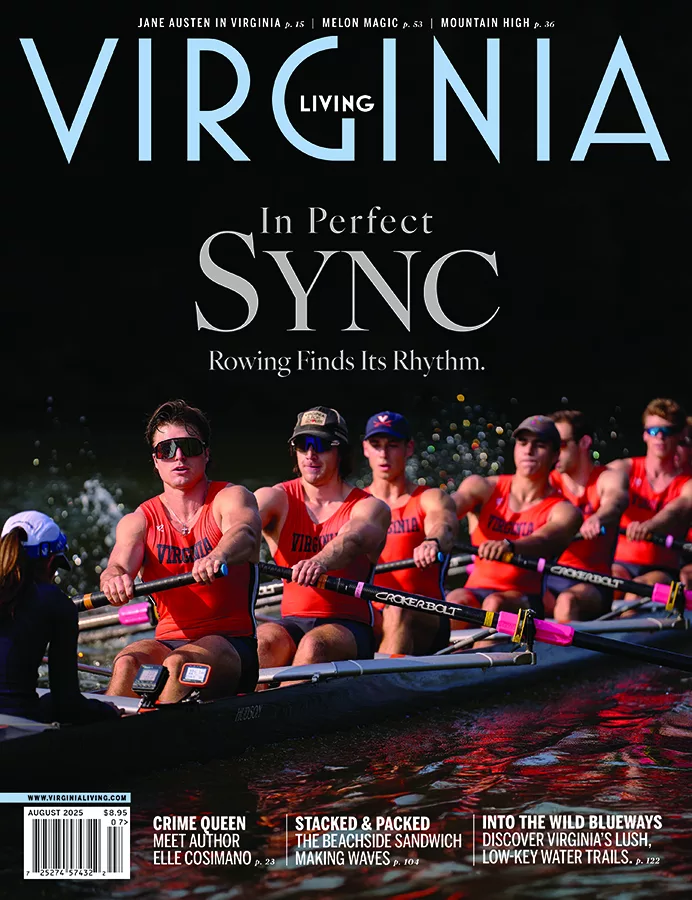Physical, dirty and even a bit dangerous, extreme racing is not for the faint of heart.

Robert Lamberson of Williamsburg in the Great American Mud Run.

Micki Long slogs through mud in the Warrior Dash.

Nelson Wu in the Super Spartan Obstacle Race.
Nelson Wu had already run a couple of half-marathons when he decided last year he needed a new challenge—something more fun and less repetitive. So Wu, a 25-year-old facilities engineer at Fort Belvoir, drove to Leesburg in September for the Super Spartan, a down-and-dirty athletic event featuring more than eight miles of military-style obstacles.
His adrenaline pumping, Wu slogged through mud, scaled makeshift wooden walls, leapt over burning logs, carried heavy sandbags and even crawled under barbed wire. And in doing so, he joined the swelling ranks of tens of thousands of Virginians who, over the past few years, have helped fuel the staggering growth of extreme obstacle events.
“It’s not your regular workout high,” Wu says. “There’s an element of danger.”
Despite the veneer of danger—and partly because of it—more and more people are doing obstacle events in localities across the state, including Wintergreen, Richmond, Aldie, Chesapeake, Sterling, Chesterfield County and Virginia Beach. The event names can be daunting and over-the-top: Rugged Maniac, Tough Mudder, Warrior Dash and the Rogue Runner, just to name a few. Then there are the Super Spartan’s sister events, the Spartan Beast and the 40-mile, invitation-only Spartan Death Race, with its bleakly blunt website, YouMayDie.com.
The industry’s growth is impressive. From 2010 to 2012, Tough Mudder grew from three events to 35, with participation growing from 20,000 to 460,000. The Warrior Dash drew 2,000 people to its inaugural event in 2009. Then, with 50 races nationwide in 2012, Warrior Dash participation reached nearly 600,000.
Why have these events become so popular, so fast? Danger can’t be the only appeal. (In fact, Spartan Death Race aside, these events look and sound far more threatening than they are.)
Novelty—the change of pace that attracted Wu to the Super Spartan—is a much bigger draw, as is the full-body workout. Plus, there’s a nostalgic allure; participants find themselves doing things they probably haven’t done since childhood: Sloshing through mud puddles on purpose, climbing thick ropes and swinging from the cold metal rungs of monkey bars. Afterward, soggy, scratched and caked in mud, they celebrate together with free beer and live music.
“It’s much more of a party atmosphere than at some traditional races, where you run and get your medal and go home,” says Micki Long, 48, of Richmond. Long owns Three One One Productions, which puts on the Watermelon Festival in Richmond’s Carytown among other events.
Long started exercising three years ago and quickly realized that “running down the street bores me to death.” She began boot camp work outs, then participated in the Rugged Maniac in Petersburg and the Warrior Dash. She recently signed up to go skydiving for the first time.
“It gives you a sense of accomplishment,” she says, “and you kind of catch the fever.”
Compared to traditional races, obstacle events provide physical and mental challenges in a more festive, unpredictable environment. That’s proving to be a powerful draw for weekend warriors who crave an experience that is more raw, more primal than their normal 9-to-5 lifestyle affords.
“People are sitting in corporate America, in air-conditioned offices, remembering a time when they were more active, more fit, when they played on sports teams and spent more time outdoors,” says Jane Di Leo, public relations manager for Tough Mudder. “It really taps into the need to get out from behind your desk and to use our bodies the way they were meant to be used.”
Ironically, the time we spend indoors in front of computers has helped mud-and-obstacle events gain traction. That’s because their industry’s rapid growth owes a tremendous debt to online social media.
“Ten years ago, you needed a database to do this,” says Jon Lugbill, executive director of Richmond’s Sports Backers, perhaps best known for staging two popular races, the Anthem Richmond Marathon and the Ukrop’s Monument Avenue 10k. “In today’s world, all you need is some online marketing savvy and you can get big pretty quickly.”
Lugbill’s group has entered the mud-and- obstacle game, too, creating the Filthy 5k on Brown’s Island and the Henricus Dauber Dash, held each summer at Henricus Historical Park.
Of course, social media can fuel both rapid success and an equally rapid decline. Organizers of obstacle events realize they must create new, even more extreme challenges each year to keep people interested. They’re also facing more competition these days, thanks to the emergence of fledgling events with ever-quirkier themes, such as spraying participants with color or foam.
Matt Robinson, a race organizer with Chicago-based Red Frog Events, the company behind the Warrior Dash, which was held last September at Berkeley Plantation in Charles City and attracted 9,000 (29 percent more than the year before), says he welcomes the competition.
“It pushes us and everybody out there to put on events that people like,” he says. “It’s certainly an industry that’s boomed over the past few years. We want to make sure it keeps growing and getting better.”
Finding the Extra Gear
Sports psychologist helps athletes thrive.
Are you worried the Tough Mudder might be a little too … tough? Or concerned you might get conquered by the Warrior Dash? If so, heed the advice of sports psychologist Dr. Dana Blackmer: While training your body, don’t forget to train your mind.
“Your head can either help you or get in the way,” says Blackmer, founder of The Extra Gear in Richmond. “That’s true whether you’re an elite athlete or a weekend warrior.”
Blackmer consults with athletes of various ages and skill levels to boost confidence, reduce nervousness, recover from injuries and, ideally, find that coveted extra gear—the ability to perform their best when it really counts. He has counseled Olympic hopefuls, triathletes and members of the Richmond Flying Squirrels baseball team.
Yet he says the same tips he gives them can help the rest of us do better in our 5Ks, marathons, bike races and mud-soaked obstacle events—and to enjoy them more.
One key, Blackmer says, is to avoid negative “self talk,” that inner commentary that can increase anxiety and cause muscle tension. Another strategy is to do your homework: If you’re training for a race or obstacle challenge, look at photos and videos of past events. Ideally, visit the course ahead of time to mentally rehearse surmounting the challenges.
Don’t beat yourself up mentally during the event, he says, even if your quads are burning, you’re out of breath and you’re tempted to quit. It’s far better, he adds, “to be positive, supportive and realistic with yourself. Say, ‘This is tough, but I can do it. Yes it’s raining today, but it’s raining on everybody.’ Just keep going, find your rhythm. Think of what a good friend or coach would say to you when you’re struggling, and that’s what you should be saying to yourself.”










